
Thomas Penn
By Cyrus T. Fox
Secretary of the Historical Society of Berks County and Secretary and Historian of "The 175th Anniversary"
Founded in 1748--Climbs to City of 115,000 Population
Oh! these hallowed remembrances can never decay,
For they come on the soul with a magical thrill,
And in days that are darkest they kindly will stay,
And the heart in its last throb will beat with them still.
The sons of William Penn did well in the selection of the site of Reading, named after their father's birthplace--the shiretown of Berkshire, England. Ascending the Schuylkill River, it was after they had passed the break in the mountains, generally accredited as a part of the Blue Ridge (also known as the South Mountains) that they found a gently sloping plain, hemmed on its southern and western borders by the river.
It was an ideal site, offering excellent surface drainage, and possessing an area sufficient for a large town. The Indians were the first occupants of the territory. They were members of the Minsi tribe, connected with the nation known as the Lenni Lenape.
William Penn, who had obtained a grant of the Province of Pennsylvania from King Charles II of England in 1681, recognized the rights of the Indians to the land, and made a treaty with them whereby they abandoned all claims. The English had come into possession of the country in 1664 by conquest from the Dutch. When William Penn died in 1718, owner of the section of territory upon which Reading now stands, it was found that he had devised it by his will to his children.

Thomas Penn
Beginning as early as February 19, 1773, Thomas and Richard Penn, sons of William, had caused patents to issue to a number of individuals. The largest purchasers were Richard Hockley, tract of 1,150 acres; Thomas Lawrence, for tracts of 300 and 137 1/2 acres, and Samuel Finney, 126 acres.
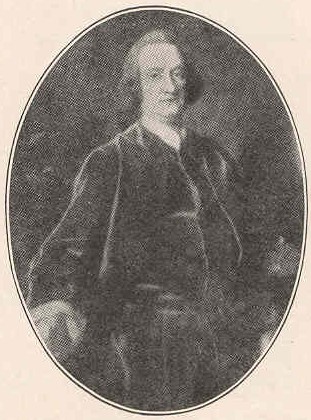
Richard Penn
Subsequently, when Thomas and Richard Penn looked forward to the laying out of a town, they repurchased these lands, although they had some trouble with Lawrence, who preferred to hold the two tracts that he had bought, and it was not until 1745, when the Penns had laid out some lots, that Lawrence reconveyed to them his tracts.
During the summer and early fall of 1748, Thomas and Richard Penn employed Nicholas Scull, Surveyor General of Pennsylvania, to layout a town on the Schuylkill River (Reading's present site), and, according to the records, the work of surveying 520 lots and 204 out-lots was practically completed by the first week in October, 1748--the time thus conforming with the dates chosen for Reading's 175th Anniversary.
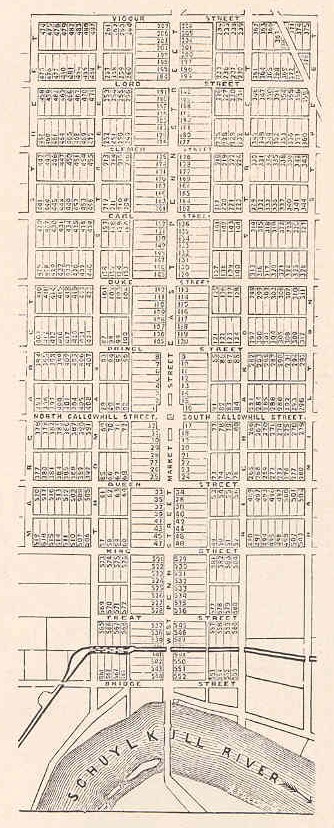
The Plan of Reading in 1748
That part of the town for two blocks north and south of Penn Street was laid out as the streets now exist. The two blocks now forming our grand Penn Square are evidences of the foresight of the founders, unequaled as they are as a central plaza by any other city or town in Pennsylvania.
The town lots were sold at public sale, and many of the names of early purchasers are those of honored ancestors of some of Reading's citizens. The commissioners appointed by Thomas and Richard Penn (who in the first deeds were termed the "Proprietaries") were Conrad Weiser, Francis Parvin and William Hartley. Publication of the proposed sale was made, and on the 15th of June, 1749 (no doubt in Penn Square), the conditions were read to the assembled audience.
As Berks County was not formed until 1752, most of the first deeds were not recorded until that year, although some were recorded earlier at Philadelphia, then the seat of justice for Reading. The first deeds, or patents, from the Penns, of which we have evidence, are embraced in the year 1751, when seven lots were recorded, all by persons who had already built upon them.
The first deed was to Conrad Weiser, then Judge of the Courts and a well-known Indian trader and interpreter, who had already built "the old white store" at the northeast corner of Fifth and Penn Streets, on the lot he purchased. The building has been marked with a tablet by the Historical Society of Berks County.
The first buildings in Reading were located along the river, where there were fords, with trading posts close by, where trades were made with the Indians. There were a few scattered buildings, mostly of log, in addition to these. The traders shifted between Philadelphia and Reading, and the permanent population in 1748, when the town was laid out, is estimated to have not exceeded 150.
The growth commenced with the selling of town lots, quickly followed by the erection of houses, so that when the County of Berks was formed, March 11, 1752, with Reading as the county seat, the number of inhabitants had increased to 378, and of dwelling houses to 130. There were, also, three places of worship--Lutheran, Reformed and Friends, all erected in 1751.

The First Court House in Berks County
At the time that Berks County was formed, the population of the county was about 12,000, located mostly south of the Blue Mountain. There were at that time some sparsely settled districts, of considerable area, forming part of the county, situated north of the Blue Mountain, which later became parts of Schuylkill and Columbia Counties. When Berks was formed, there were but six other counties in Pennsylvania.
For assessment purposes a district was formed by adding a part of the adjoining township (Alsace) to Reading, which was called the "Township and District of Reading." The boundary lines were fixed by the court in 1761 and embraced about 950 acres. To discover the taxpayers of Reading of the period within ten years of that time, it is sometimes necessary to search the lists of Alsace Township.
In 1762 a court house was erected in Penn Square, which was in use until 1840, when the present building at Sixth and Court Streets took its place, having been erected during the years 1838-1840 at a cost of $59,000.
The first market house was built in 1766 and public market houses continued in Penn Square until 1871. A county jail was erected at the northeast corner of Fifth and Washington Streets (then Callowhill and Thomas Streets) in 1770.
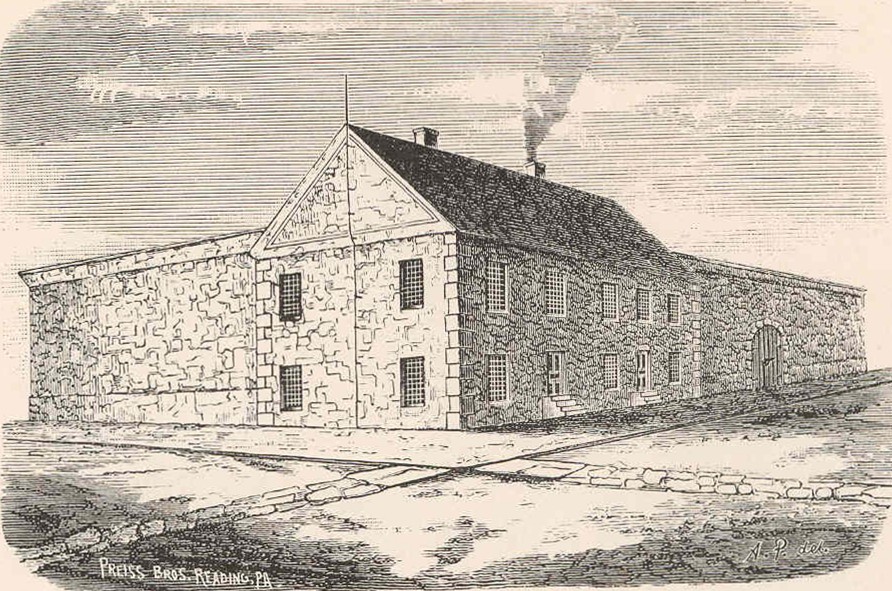
The Old Jail
The names of most of the streets were originally named after members of the Penn family, except such as King, Queen, Prince, Duke, Earl, etc. A change in the names of streets took place in 1833.
The first fire company, the Rainbow, was organized March 17, 1773. It was a volunteer organization and was, therefore, the pioneer in Reading's present system, which is, in consequence, the oldest volunteer fire department in the United States, in continuous existence for 150 years, and the 150th anniversary of which will be celebrated in connection with the 175th anniversary of the founding of Reading.
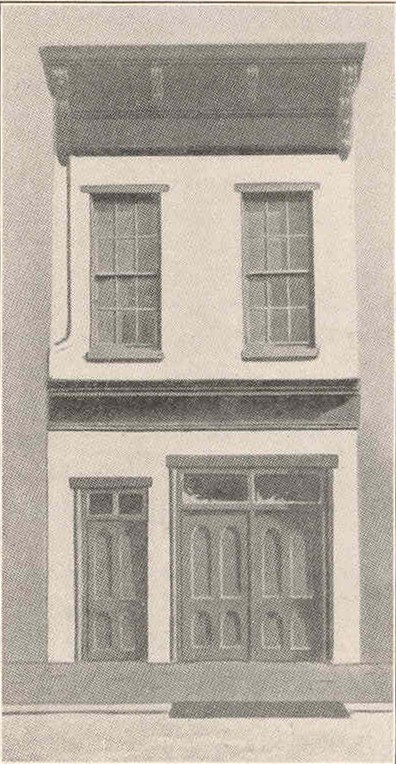
First Quarters of the Rainbow Fire Company
However, Reading had hardly been laid out as a town, in 1748, when the thought of fire protection had taken a strong hold upon the people. The old English idea of the fire bucket prevailed and among the first to organize some of the inhabitants as fire preventers and extinguishers was Conrad Weiser, the merchant and Indian trader. Effective service is said to have been rendered on several occasions by these early fire fighters.
It was in 1770 that a number of persons began agitating the formation of a fire company. This continued until the latter part of 1772 when several meetings were held. In the winter of 1772-73 the plan of organization assumed a tangible shape and on March 17th, 1773. a company was formed officers were elected and the name Rainbow was adopted.
The 150th anniversary of the Rainbow Fire Company was celebrated by a banquet on Friday evening, March 16th, 1923, and the following day, Saturday, 17th, the actual date of the anniversary was set aside as a day of festivity by the members of the company and their guests.
Two of the oldest buildings of Reading remain, built prior to the American Revolution. The one is located on the northwest corner of Fifth and Washington Streets, and general business purposes, with apartments on the upper was for many years occupied as a hotel. It is now used for floors. The two lower stories are the original portions, the building having been erected by Michael Bright in 1760 for a tavern, which he, and afterwards his sons, successfully conducted for many years.

Farmers Bank Building
The other building is on Penn Street near Fifth, occupied for many years by the Farmers' National Bank. It has been devoted to banking purposes since 1814. Previous thereto it was known as the Federal Inn, in which Adam Witman, the owner, conducted a hotel. It was built by Witman in 1763, and there is a record of General Washington having stopped there on the night of October 1, 1794. In honor of this event a tablet was placed on the building by the Berks County Chapter, Daughters of the American Revolution.
Reading was incorporated as a borough on September 12, 1783. It then had a population of 2,150 inhabitants, over 400 of whom were taxpayers. It was then conceded to be the largest and most progressive inland town in the United States. Its officers were a Burgess, four Assistant Burgesses (corresponding in number with the Mayor and Council of Reading's government in 1923), a High Constable, Treasurer, Clerk, two Supervisors and two Assessors.
At that time Berks County had a population of about 25,000. The more important places in the county were Hamburg, Womelsdorf, Kutztown, Birdsboro and Morgantown. A large portion of the inhabitants of the county were of German origin, even the town of Reading founded by the English having then a considerable surplus of Germans in the population.
However, a number of nationalities were embraced in Reading's population, people of different nations having been attracted to the town by the advantages which it offered. The first newspaper in Reading (established in 1789) was printed in German, and it was not until 1816 that an English newspaper was printed here. The government opened a post office in 1793.
Among the early public buildings was the "State House," on the northeast corner of Fifth and Penn Streets, in which several county offices were located. It was used for public purposes until the county took possession of the new court house in 1840. The first market house in Penn Square was succeeded by a second in 1799. Both were rebuilt in 1846, having a combined capacity of 70 stalls and 116 stands. A paved area at the end of each market house afforded locations for additional stalls. The market houses were abandoned in 1871, owing to private enterprise having provided new and better-protected buildings more conveniently distributed.
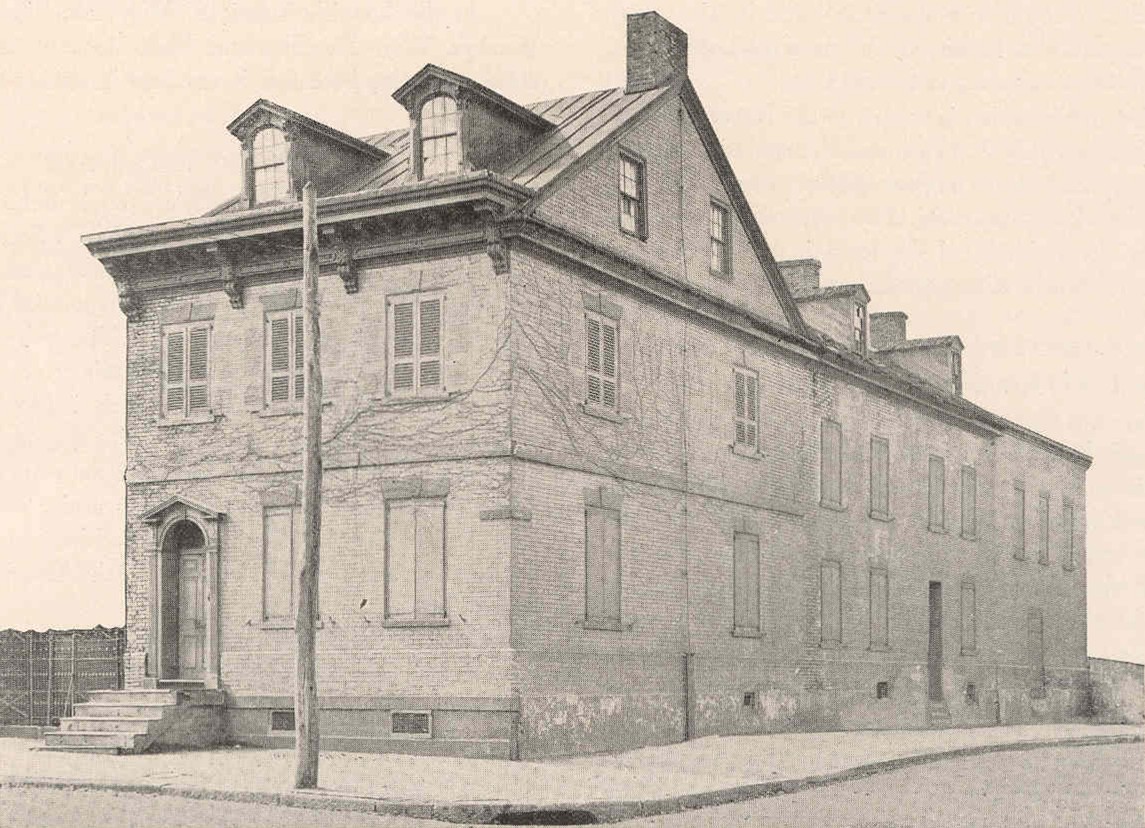
One of the Original Homes, Fifth and Walnut Sts., which Was Recently Razed
The market house bell, cast in England in 1799, and which for more than seventy years had called the people of Reading to market, disappeared in 1871 while the buildings were being razed, and was kept in seclusion until the fall of 1918, when it was located and restored to the public through the medium of the Historical Society of Berks County, and is now in the society's possession, to be preserved for the inspection of future generations. It was rung for the first time in 47 years on Armistice Day, November 11, 1918, when it was taken through the streets of the city on a truck and sounded the joyous notes proclaiming peace.
Reading will soon be in possession of the old court house bell, which during the Revolution called the people to arms. After being away more than 70 years it was secured this year by Dr. R.B. Ludy, of Atlantic City, for the Historical Society of Berks County.
Reading has been first in all wars in which this country has been engaged. When the fire bell tolled on Armistice Day, in commemorating the close of the World War, it bore testimony to the bravery of the thousands of young men who responded to the call to the colors, and it, also, commemorated the fact that in this, as well as in all earlier wars, it had sent the first company to the field.
The first public action in regard to the Revolution was held in Reading on July 2, 1774, and the enthusiasm of the people was aroused to the highest pitch. From that time until the declaration of peace in 1783, remarkable zeal was displayed by the residents of the town in behalf of independence and representative government.
In April, 1775, two companies of infantry were recruited here, and one of them, commanded by Captain George Nagel, had the honor to be the first to report from Pennsylvania after the Battle of Bunker Hill, having marched to Cambridge, Mass., which required steadfast traveling for several weeks. Of the nearly 10,000 men furnished by Berks County during the Revolution, the greater number of them saw actual service.
It was the 1,700 men of Berks County who went to the relief of Washington after the Battle of Brandywine and deterred the British from continuing farther inward, their design having been to seize the large quantities of ammunition and other military supplies stored at Reading. Many of the Berks County soldiers who went to Washington's relief shared with him the privations of that miserable winter of 1777-78 at Valley Forge.
Reading, as a store house for supplying the patriot army, had the people of the entire district furnishing contributions of flour and grain as well as clothes and military accoutrements, while shot and shell, as well as cannon, were being provided by nearby furnaces and iron works.
One of the companies that has had a military existence of 129 years originated from men who saw service in the Revolution. This company was reorganized in the spring of 1794 as the "Reading Artillerists," under which name it has continued an active organization ever since.
The Reading Artillerists was the first company from this section to enlist in the "Second War with Great Britain," 1812-14. It, also, sent the first company into the Mexican War, and was represented in the Ringgold Light Artillery, that left Reading in the evening of April 16, 1861, to answer President Lincoln's call for troops to suppress the Rebellion, and which holds the record of having been the first company in the field. Sworn in, with four other Pennsylvania companies on April 18, 1861, the five are today known as "The First Defenders," and the members of these companies, in attestation of this service, were granted medals of honor by Congress.
In the Spanish-American War and in the recent World's War, Reading and Berks County enjoyed the credit as having been first in the field in answer to the country's call.
The French and Indian War, fought before the Revolution and continuing from 1755 to 1762, affected Reading more or less. The town had just entered upon a period of growth and the people were stirred by reports of Indian raids and the occurrences of massacres in Albany Township and other districts close to the Blue Mountain.
Conrad Weiser, who had much influence with the Indians, used his good services, he being engaged in business in Reading during the entire period of the war, although residing on his farm in Heidelberg Township, near Womelsdorf, which farm is to be acquired and held as a memorial by the Conrad Weiser Memorial Park Association, lately formed.
Weiser, who for a short time held a commission as colonel, and who was Berks County's first judge, was aided very materially in his efforts by Captain George Nagel and Edward Biddle, the latter having been one of the representatives from Pennsylvania in the First Continental Congress.
Reading, likewise, furnished Dr. Bodo Otto, who, as surgeon general of the army, was with Washington at Valley Forge, as well as his son, Dr. John B. Otto. A monument in memory of Dr. Bodo Otto is in the small burial plot to the west of Trinity Lutheran Church, of this city, and an oil portrait of him may be seen in the building of the Berks Historical Society.
The location of Reading was originally known as "The Ford," being the point in the road that led from the "Tulpehocken Settlement" to Philadelphia. This Settlement is older than Reading by 25 years, its 200th anniversary having been but recently celebrated. The few trading houses at the ford were sufficient to cause Thomas and Richard Penn to see the propriety of laying out their proposed new town along the eastern section of the land skirting the Schuylkill River.
The river was forded by horses and cattle and old-time vehicles, in the early history of Reading, until 1783, when a ferry was established. This was operated until 1815, when a covered wooden bridge was constructed by the county commissioners. In 1831 another covered bridge was built at the foot of Bingaman Street. Each bridge was rebuilt, both having been damaged by the freshet of 1850, and the one at Bingaman Street later being destroyed by fire. In their places are magnificent viaducts erected by our county commissioners within recent years.
The stage coach was the early means of communication between points within and outside of the county, and for years was useful in transporting the mails.
Packet boats were also run on the Schuylkill, and berths and meals were furnished the passengers, a trip between Reading and Philadelphia requiring the best part of two days. Much merchandise was carried on these vessels, and brisk scenes were enacted at the wharves at the foot of Penn Street and between there and Levan's Ferry, afterwards the site of the Bingaman Street bridge. The first bridge across the Schuylkill, near Reading, was on the road to Sunbury, through Bern Township, the same having been erected in 1810 at the site to be occupied by the Schuylkill avenue viaduct.
The establishing of stage lines, the first coach having arrived in Reading from Philadelphia in 1789, resulted in the agitation of the public in behalf of better highways, and it was not long before turnpike companies were organized.
In 1805 the Centre Turnpike was completed, running northward through Hamburg to Sunbury. A second followed in 1810, from Reading to Philadelphia, via Pottstown and Norristown, and was given the name of Perkiomen. A third, extending westwardly from the foot of Penn Street, through Sinking Spring and Womelsdorf, was completed in 1817, and called the Berks and Dauphin Turnpike.
Following on the heels of providing better roads came the desire of the public for transportation lines. Communication by water attracted attention as a cheap and convenient mode of transportation, and was, especially, deemed very desirable because of the discovery of anthracite coal in the vicinity of Pottsville, and the taking of specimens of this coal to Philadelphia by Colonel George Shoemaker, a resident of Pottsville, but of Berks County connection, who took a sufficient quantity in the saddle bags on the horse which he rode to demonstrate its burning qualities.
The Schuylkill Canal was the first waterway to be constructed, primarily for the transportation of coal. This was completed in 1822 between Pottsville on the north and Philadelphia on the southeast. The Union Canal was built as far as Lebanon in 1828, and then extended west to Middletown, on the Susquehanna River, at the mouth of the Swatara, one of that river's most important tributaries. For many years these canals were operated with great advantage to the communities which they served. The most important products carried were coal, grain and lumber.
The next important development along transportation lines was the construction of railroads. The Philadelphia & Reading was the first to be projected, the intention being to unite the City of Philadelphia with the coal regions, and, especially, with the then rapidly growing town of Reading, the center of a large and important business with interior Pennsylvania.
The railroad was completed to Reading in 1838 and to Pottsville in 1842. On account of its advantageous location, the Company built its shops here, which proved at once a great help to the town, resulting in its rapid advancement over rival places in the State.
Other railroads followed, which eventually became incorporated in the Philadelphia & Reading system, such as the East Pennsylvania and Lebanon Valley, both in 1857. The Reading & Columbia was extended to the southwest in 1864, connecting Lancaster and Columbia with Reading. The Wilmington & Northern and the Berks County Railroad, the latter being now known as the Schuylkill & Lehigh, were later enterprises.
Another important event in the railroad history of Reading was the construction of the Schuylkill Valley Division of the Pennsylvania Railroad in 1884, which has afforded direct connection with all the lines and tributaries of the great Pennsylvania Railroad.
There was a time when Reading was dependent upon its supply of water for household purposes on wells and pumps. In almost every square on Penn Street there were pumps from which the people were supplied. There were, also, pumps in Penn Square at the market houses. Cisterns, which caught rain water, furnished a supply for the washing of clothes. There were numerous springs from which families obtained wholesome drinking water. These disappeared with the erection of dwellings.
The first pump in Reading was supplied in East Penn Square by direction of the Penns. When the first market house was built in 1766, this pump was given a central place. The well was 53 feet deep and furnished a strong supply of limestone water. It was abandoned in 1871, when the market house was removed.
A private water company was formed in 1821, which collected the water of several springs near the head of Penn Street and on the western slope of Mt. Penn. As the demand for water increased, the rates were advanced. Finally, after proceedings in equity had been commenced against the company in 1864, in which the city was made a co-defendant, the city purchased the rights and franchises of the company in the following year for $300,000.
The water supply of the city was increased in 1874 by the introduction of the Antietam Creek, and in 1889 of the Maidencreek, so as to be now in excess of 45,000,000 gallons per day. This will be greatly increased by the construction of a series of dams in the Maidencreek and additional reservoir storage capacity, these improvements forming a part of the city's present splendid water program.
Reading is supplied by a fine system of sewers. Formerly, when mountain streams overflowed, there was a deluge in the gutters and properties were flooded. In 1893 the West system of sewers was adopted by Councils, and in 1897 an improvement, known as the Bassett system, was introduced. These systems have been extended and enlarged, much to the advantage of the citizens. There are now 100 miles of house drain and 30 miles of storm water sewerage.
The lighting system of Reading is greatly to be extolled. It may seem a long way from the tallow candle to the electric light, but the writer was born in Reading when the tallow candle, reinforced by the fat or lard lamp, held sway. When coal oil came it was considered a great step in advance. Then came gas, and now we have the advantage of electricity. It is not, however, so long since the gas lamps, for street lighting purposes, were relegated to the rear. Electricity has, also, come largely into use for manufacturing purposes.
The fire companies of Reading require special mention, because their 150th anniversary is being jointly observed with Reading's 175th. The State Firemen's Convention honors us with their presence. All hail to the valiant firemen of Pennsylvania!
The convention has its own official program of the week, and this will give data and statistics concerning the firemen. Reference has already been made in this article to the Rainbow Fire Company, the oldest in Reading's department.
The Reading Volunteer Fire Department consists of 14 companies. It is not only the largest in the United States, but, according to Earle I. Koch, President of the Volunteer Firemen's Relief Association, in an address which he delivered before the Historical Society of Berks County, it is the largest volunteer fire department in the world, and is so referred to in the Encyclopedia Britannica, one of the greatest of all authorities.
The total membership of the 14 Reading fire companies is over 6,000. All are controlled by a body known as the Firemen's Union, which is composed of five delegates elected from each company.
Of churches and schools nearly all religious denominations are represented in Reading, there being 106 churches in all, and the city is noteworthy for its fine edifices. The public school system is to be commended for the progress that it has made within a few years and for the extensive building program now in progress, which ultimately, will add $4,000,000 to the total amount invested in school buildings.
A new junior high school, erected at a cost approaching $1,000,000, is a model in every respect, and will soon be succeeded by another equally as notable.
The Reading Museum and Art Gallery, conducted under the supervision of the Board of Education by Dr. Levi W. Mengel, director, is one of the city's chief attractions. Reading owes much to Dr. Mengel for his earnest efforts.
Reading holds the record of being a pioneer in the American iron industry. The town was early a center in this respect, with furnaces, foundries, rolling mills, sheet mills and other iron establishments in full operation. Reading was one of the earliest producers of stoves and castings. Having furnished shot and shell in the Revolution, it produced heavy ordnance in the Civil War.
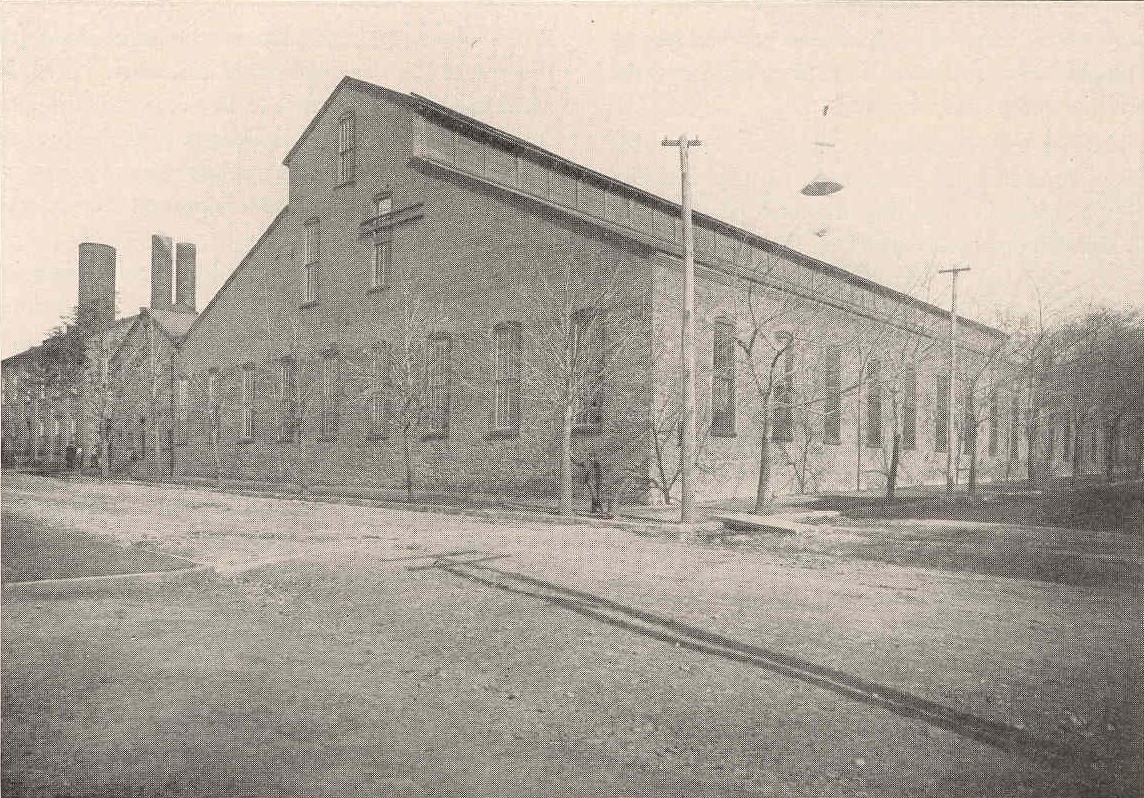
Scott Foundry
The largest piece of ordnance in this war, a 20-inch cannon, was produced at the Scott Foundry, this city, and many other pieces, of 12-inch and 16-inch calibre, were manufactured in the same establishment.
It is the pride of the citizens of Reading to be known as the "third industrial city" of Pennsylvania. In view of its more than 700 manufacturing plants, it is well entitled to that honor, although this distinction has been claimed by another city, which recently published a list of its industries, showing a total of 283 against Reading's more than 700.
It would be interesting to enumerate all the branches of manufacture represented in Reading establishments, but there would not be space enough in this pamphlet, which is designed principally to give a program of the entertainments, pageants and parades during the week of Reading's 175th Anniversary, beginning with special services in the churches of the city on Sunday, September 30th, and ending on Saturday, October 6th, the entire week being devoted to the memorable occasion.
One of the first industries of Reading was "the manufacture of wool hats," and this is accounted as one of the town's main features in an English gazetteer published prior to the year 1800.
It might be stated, however, that Reading now has seven manufactories of felt hats and four of wool hats, all large and important of their respective classes. Several of these establishments have histories going back more than 100 years.
One of the later industries is the manufacture of hosiery. In this respect Reading is one of the largest in the world, with 172 establishments in full operation. These manufacture all the grades of silk, silk-chiffon, silk and fibre, mercerized, lisle, cotton, wool, and wool and silk known to the trade.
Other examples might be given of the lines of the various industries of Reading, but the classification would prove tedious, and might not interest the reader.
Reading has long been known as a hardware centre and for its manufacture of machinery of all kinds. Automobiles and parts make a long list. One of the highest priced automobiles in the market is made in Reading.
On account of its bakery products, but particularly of its eight bakeries which have produced for years that edible biscuit known as the "pretzel," Reading was given, a few years ago, the name of "The Pretzel City" by a facetious individual, although more deserving of that of "Hosiery City," on account of its preponderance of hosiery mills, and having one of the largest establishments of its kind in the United States, and perhaps in the world.
The capital invested in the industries of Reading is represented by over $100,000,000. The value of the annual products is in excess of $200,000,000, that of hosiery alone being over $60,000,000.
Local cigar factories produce annually upwards of 160,000,000 cigars of the better grades, and, with the output of nearby factories, the annual output is over 180,000,000. These represent a value of $90,000,000.
Reading is the second largest centre of builders' hardware manufacture in America, it might have been stated before. It is the home of one of the leading spectacle factories in the world, and one of the most extensive producers of Holland window shades. It is, also, celebrated for turning out the highest type of motorcycle that can be manufactured.
The banking facilities of Reading are unsurpassed. The 16 banks and trust companies have annual clearings of $150,000,000, over $50,000,000 of which represents the wages paid through the banks to our industrial workers, numbering more than 28,000, of whom 12,000 are females.
As a city of homes Reading is far in advance of cities of similar population in the United States. There are over 24,000 dwelling houses, 50 per cent, being owned by their occupants. The number of buildings of all kinds, according to the books of the City Assessor, is 30,700. This includes manufacturing establishments, business places, hotels, garages and other structures.
The total valuation of properties is $108,995,728, of which amount $10,122,950 represents buildings exempt from taxation, such as churches, hospitals and similar institutions. The total assessment of property subject to taxation is $98,872,778.
There are other figures which should be presented to tell Reading's story of growth and development. The census of 1920, for instance, gave the city a population of 107,784, to which can be added the suburbs, making a total of 132,000. Reading thus held fourth rank in Pennsylvania. A subsidiary census, taken, however, in 1922, increased the population of the city within its boundary lines to over 110,000. In the spring of 1923 a directory census gave Reading a population of 115,000, which included a few outlying districts.
As Reading has 80 suburbs in compact territory, all embraced within a radius of three to four miles of the heart of the city, according to a survey made by the writer in November, 1922, the population of the entire Reading district, including the suburbs referred to, can safely be placed at 135,000.
Included in this estimate are the Boroughs of West Reading and Wyomissing, immediately across the river from Reading (the two boroughs being so adjacent that it is difficult to discern where one ends and the other begins), and the Borough of Mt. Penn, immediately on the east of Reading. These boroughs vary from 3,500 to 4,000 in population and are increasing rapidly.
The Wyomissing industries (comprising hosiery and underwear, narrow fabrics and textile machinery) are among the largest employees of male and female labor in this country. Hundreds of dwelling houses are in course of construction this year (1923) in Wyomissing, as well as a hospital at an approximate cost of $1,000,000.
Industrial Reading boasts of having the largest plants of their kind in the world, viz.:
Producing full-fashioned knitting hosiery machinery.
Single thread lace machinery.
Wrought iron pipe.
High-grade alloy steels.
Small steel castings.
Glove silk underwear.
Menthol cough drops.
Heat-treated automobile frames.
Goggles. Children's shoes.
Narrow fabrics.
Butcher blocks.
Holland window shades.
Optical goods.
Full-fashioned hosiery.
Reading is, likewise, according to a summary of its industries made by the local Chamber of Commerce, "the home of the largest foundry under one roof in America; it has the largest brick-burning kiln in the country, and has plants producing high-grade motor cars and trucks, wool and felt hats, clothing, confectionery, locomotives, paints and varnishes, cigars, abattoir products and varieties of metal products."
The location of Reading is unsurpassed. It is surrounded by beautiful, undulating valleys. It has in its environments hill and mountain scenery. From points overlooking the city are views of magnificence, covering hundreds of square miles in extent, with Reading and its suburbs at one's feet, affording views with which one never tires.
The country is of historic interest. Nearby is the birthplace of Daniel Boone, the Kentucky pioneer, born in Berks County October 22, 1733.
Near to the Boone birthplace is the log house built by his grandfather, George Boone, in 1720.
In the same neighborhood is the Lincoln house, built in 1733 by Mordecai Lincoln, the great-great-grandfather of President Abraham Lincoln.
Fourteen miles west of Reading is the Weiser farm, where Conrad Weiser, father-in-law of Henry Melchior Muhlenberg, founder of the Lutheran Church in America, located 200 years ago.

Henry Melchoir Muhlenberg
The first furnace in Pennsylvania (Colebrookdale) was established in Berks County in 1717, and throughout the county are the sites of many early iron works--furnaces and forges.
Days can be spent in visiting the many points of interest in and around Reading, and with the improvement in the highways, largely due to the interest and vigilance of the Reading Automobile Club, these excursions by motor car will prove a never-ending pleasure.
Reading has an ideal electric railway system, so that many of the points of interest in the county can be visited by trolley. A number of historic spots have been marked within a year by the Committee on Historic Sites, of the Historical Society of Berks County, appointed by the Society's President, Dr. C.R. Scholl, who has been enthusiastic in rendering his assistance in this matter.
The city is especially noted for its extensive public library, its museum and art gallery (previously referred to); its historical society, with its complete files of newspapers, library and museum; its Schuylkill College, technical institute schools and business colleges.
There are 303 acres of parks, with wholesome amusements for all. The scenic beauty of these delightful recreation spots is unexcelled.
The city occupies a large place in a business way, with its 250 wholesale establishments and 2,350 retail stores.
Other advantages possessed by Reading are its modern hotels, its ideal home community, its wholesome filtered spring water, its attractive and orderly amusements (20 theatres and moving picture houses), its auto bus service to points north and east of the city; its motor truck service daily to New York and Philadelphia; its moving van opportunities, making changes in dwellings or apartments cheaply and conveniently; its nearness to Philadelphia (58 miles), to the seashore, Atlantic City, 120 miles, and to New York, 126 miles.
Its substantial, industrious and thrifty people results in good and desirable neighborhoods.
The taxes of Reading will compare favorably with those of most cities, being a total of 24 1/2 mills, or $2.45 per $100, based on a reasonable assessment. The tax rate is made up as follows: For city purposes, 10 1/2 mills; for the public schools, 10 mills, and for county purposes, 4 mills.
Notwithstanding an extensive bridge-building project, to which the county funds are appropriated, the county tax has not even increased. Another bridge, or viaduct (Schuylkill Avenue) across the Schuylkill, an operation which may cost, including property damages, $750,000, is now under way.
Among the first circus lots were locations at Ninth and Court Streets (northeast corner) and Sixth and Walnut Streets (northeast corner). Of course, these were small places, but sufficient for the one-ring exhibition of its day. When the three-ring circus appeared, larger lots had to be found, mostly in the northeastern section, but with the rapid growth of the city it is quite difficult at the present day to find a satisfactory location.
Some of the most popular circuses of their day, sixty to seventy years ago, were those of Hugh Lindsay and Dan Rice. Each was a great "clown," especially Lindsay, who was a native of Berks County, and could adapt his witty remarks to local conditions.
The earliest "shows" were given in ball rooms of the hotels, or in lots adjoining the hotels or inns. It was a long while before the tented arena came into vogue. Usually there was a room large enough in the inns of the day to afford sufficient accommodations for dancing and exhibition purposes.
One of the earliest "shows" in Reading was given in January, 1799, in the ball room of Barr's hotel, by a man named Salanca. It was a legerdemain performance by himself, tricks by an "educated dog," and ending with a display of fireworks.
In October, 1791, a camel was exhibited in Jacob Grant's tavern.
In June, 1808, an elephant, eight years old and seven feet high, was exhibited at Feger's hotel as being "the only elephant in this country."
On August 1, 1815, a whale (weight 5,000 pounds) was shown at William Jones' hotel.
In November, 1813, Reading had its first circus (Purdy, Carley and Bailey), and in December, 1838, William Paulin made the first balloon ascension.
Besides fairs, concerts and balls, the earlier amusements consisted of the exhibitions of itinerant showmen, which were the predecessors of the modern circus. Traveling dramatic companies also appeared, after halls had been provided, the Keystone Hall, on the west side of Sixth Street, between Penn and Court, having been the first. These were followed by the Odd Fellows' Hall, Breneiser's Hall and others, but the stages were comparatively small, so that a complete dramatic performance could not be presented with satisfaction. It was not until 1872, when Mishler's Academy of Music came into being, that a regular theatrical play could be rendered according to its various details and requirements.
As the movement for celebrating the 175th anniversary of the founding of Reading was given its first impetus (after a suggestion in the Reading Eagle by Alfred N. Burkholder, editor of that paper) at the May meeting, 1921, of the Historical Society of Berks County, this organization is entitled to more than a passing notice.
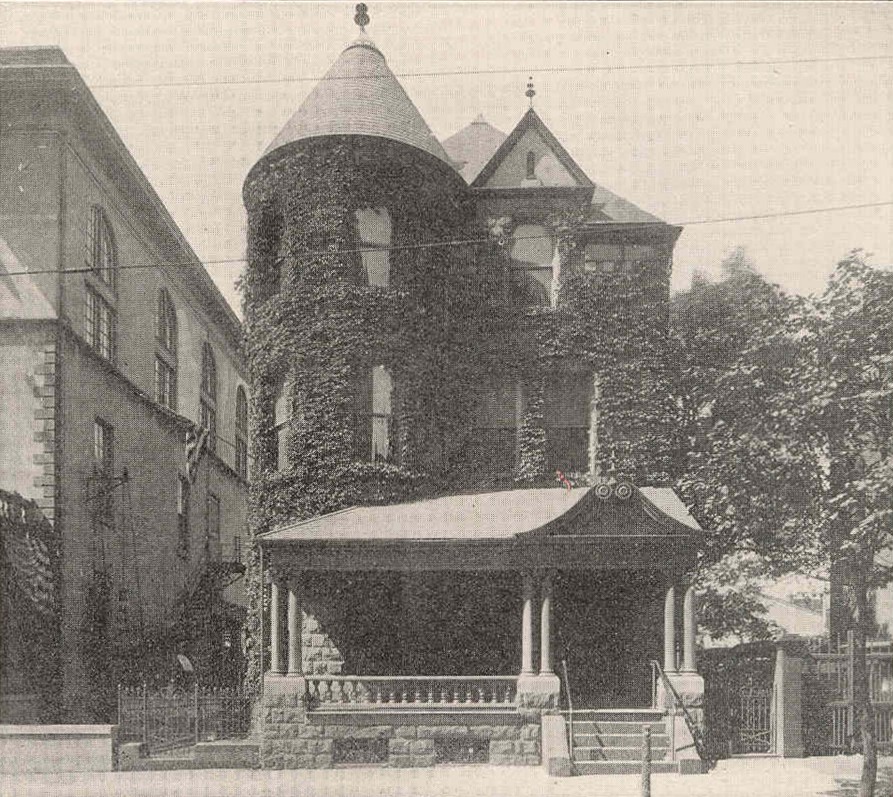
Historical Society of Berks County
It was through the adoption of a resolution offered at this meeting by Charles H. Hunter and seconded by Cyrus T. Fox that a committee was appointed by Dr. C.R. Scholl, President, to make the preliminary arrangements. This resulted in a general committee of arrangements being formed, with Messrs. Hunter and Fox President and Secretary, respectively, and, after many meetings were held, a strong working force was obtained.
The present Historical Society was incorporated December 13, 1869, and reorganized in February, 1898, since which time it has been in active operation. It has a membership of nearly 1,500 at present. The officers are: President, Dr. C.R. Scholl; Vice-Presidents, Frank S. Livingood, Rev. Dr. Charles E. Creitz, Dr. George G. Wenrich (with a vacancy caused by the death of Richmond L. Jones); Corresponding Secretary, George M. Jones; Secretary and Acting Librarian, Cyrus T. Fox; Treasurer. C.I. Miller.
A movement which should be recorded here, the same having originated in the Historical Society, to commemorate the deeds of one of Berks County's greatest citizens, and who was a merchant in Reading in 1750, two years after the town was laid out, is the formation of the Conrad Weiser Memorial Park Association, intended to convert the farm and former home of the Indian trader, interpreter and pioneer. Conrad Weiser, into a public park, the association to be maintained for preserving the Weiser farm as a perpetual memorial.
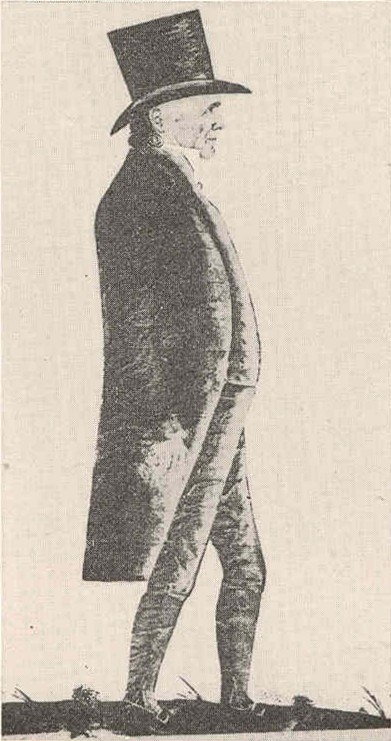
Conrad Weiser
An agreement to buy the farm has been made with the owner, L.R. Valentine, of Womelsdorf, the price having been fixed at $20,000. An additional sum of $10,000 is to be raised to provide for improvements, the laying out of a road. etc., as well as to aid in its maintenance.
On June 4, 1923, a charter was granted by the Court of Common Pleas of Berks County to the Conrad Weiser Memorial Park Association, with the following persons as the first Directors: C.R. Scholl, President; Cyrus T. Fox, Lee S. Clymer, Colonel Henry W. Shoemaker, Jacob H. Mays, Charles T. Davis and Dr. H.F. Rentschler.
At their annual state convention held in 1923, at Lancaster, the Improved Order of Red Men gave a donation and promised further assistance.
Born in Wurtemberg, Germany, November 2, 1696, Conrad Weiser emigrated to America with his father's family in 1710, landing at New York, with many other fugitives of the Palatinate, to seek religious freedom in the New World. His early youth was spent in the Schoharie Colony, above New York.
A tribe of the Mohawk Indians was nearby, and the boy, Weiser, attracted the attention of the chief, who obtained the parents' consent to live with the tribe and acquire their language, It was this experience with the Indians that gave Conrad Weiser later such a hold on the good will of the aborigines and enabled him to settle many differences between them and the whites.
In 1729 he followed the stream of Palatinate migration into Pennsylvania, and, having married, he located in the "Tulpehocken Settlement" (which had been already established). He took up a large tract of land in Heidelberg Township, built a stone house, the original portion, with an addition, being still in existence, and there reared a family.
The name of Conrad Weiser was connected, up to the time of his death, with every movement calculated to advance the interests of the City of Reading and the County of Berks. Having the friendship of the Indians, he became the mediator between the Colonial Government and the various tribes and confederates of the Red Men. As agent and interpreter he settled many contentions and effected numerous treaties. It was, in fact, through his diplomacy with the Indians that final victory was accomplished in the long struggle of the French and Indian War. President Washington, standing at his grave on November 14, 1793, uttered these words: "Posterity will not forget his services." Conrad Weiser died on his farm, near Womelsdorf, on July 13, 1760, where his remains are interred.
The fact that the Friends' Meeting House has been the headquarters during this year of the General Committee of the 175th Anniversary entitles it to be mentioned. It is the fourth place of worship of the Society of Friends, the first having been erected in 1751 in a central location in Reading. A few years later, or in 1760, another was built almost on the site of the present meeting house. In 1765 a new building, constructed of logs, took its place. This was on a lot at Queen and Thomas Streets (now Fourth and Washington) and used by the Friends for many years. When the Hessians, captured in the Revolutionary War at the Battle of Trenton, were brought to Reading, the meeting house was used as a hospital, in which many of these prisoners of war were treated. In 1868 this property was sold, and, the present structure was erected on the ground which the Society of Friends had owned for many years, and adjoining which was located their burial ground.
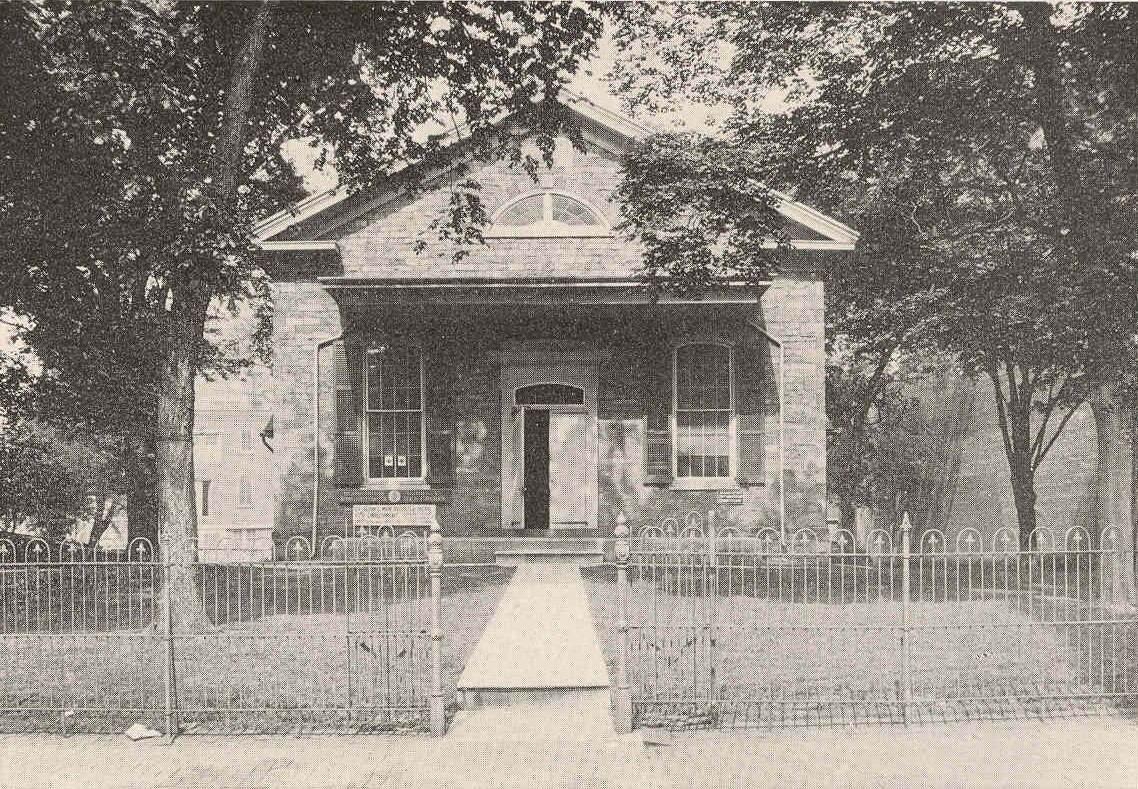
Friends Meeting House
Few cities in the United States have as great advantages agriculturally as Reading. The farms, orchards and truck gardens supply the tables of the people of Reading with unlimited quantities of produce at moderate prices. The "household markets," as they may be termed, present great varieties of vegetables in their season. This conduces to low costs of living. Nearly everything for the table is grown within a radius of a few miles of the city. Poultry and eggs fresh from the farm are constantly to be had. Berks County ranks fifth among the counties of the United Stated in egg production and thirty-sixth in total value of agricultural and live stock products.
The county is rapidly becoming one of the greatest fruit-growing districts in the United States, owing to the interest taken within the past ten years by citizens of Reading in the subject. Peach growing has especially interested many, and there are orchards of hundreds of acres in extent within a few miles of the city.
In early times the country around Reading was noted for game and fish. The Schuylkill River teemed with fish, and the hotels of the day furnished catfish for breakfast that had been caught the same morning. This fact was alluded to by John Penn, one of the original owners of the land, in a letter which he wrote to a friend concerning a night and a day spent in Reading. The writer of this article conversed years ago with one of the oldest citizens of Reading in regard to the time when a shad fishery was maintained along the Schuylkill within the limits of the town, where shad were caught in great numbers every spring.
Game was abundant in the woods. Deer were shot on the Blue Mountain and occasionally a bear was seen. Wild turkeys, pheasants and quail were numerous. Wild pigeons were to be seen in the late summer and fall in flocks of thousands. The writer remembers seeing large flocks in the county in 1858.
As to electricity, Reading is in the center of Pennsylvania's first super-power system, furnishing all the electric current needed between Harrisburg, 54 miles to the west, and Easton, 52 miles on the east, and extending beyond Easton across New Jersey to within four miles of the New York State line. Extensive development is being continued all along the system.
The daily storage capacity of artificial gas is 2,800,000 cubic feet, and the system, as controlled by the Consumers' Gas Company, is being enlarged from time to time.
As to street car service, there are 50 miles of trackage on 21 routes diverging from the centre of the city to all districts, on which are used 107 closed and 38 open cars. The city fare is seven cents. The suburban system of trolley lines is extensive, and connections are made with lines in all parts of Eastern Pennsylvania.
The celebration of the 150th anniversary of the founding of Reading took place June 5th to 11th, 1898, under the immediate direction of the Board of Trade, which organized the general committee of arrangements and appointed all committees. The opening day (Sunday, June 5,) was devoted to church services in the morning and musical concerts in the afternoon. Monday, June 6, was "Civic Day," with a public reception at the Court House in the morning, a parade of civic and fraternal organizations in the afternoon and fireworks display in the evening. Tuesday was Women's and Children's Day, with receptions in the morning, parade of school children in the afternoon and illumination and choral concert in the evening. Wednesday had as its great feature a firemen's parade in the afternoon, which was broken up by a "real fire" that took place in a Penn Square business house. Thursday witnessed the Industrial Parade in the afternoon. Friday was devoted to a "Cavalcade and Corso" and bicycle parade and races. On Saturday the week's festivities concluded with a regatta on the Schuylkill River. The affairs of the week drew thousands of visitors to the city.
More than 100 years ago a medical society was organized here, Dr. Isaac Hiester, an able physician and surgeon, having, with others, formed such a society in 1824, and for twenty-five years he was its President. This was the second organized body of physicians in Pennsylvania, the first having been in Philadelphia. It is now known as the Berks County Medical Society, and began publishing its transactions in 1896.
The Reading Medical Association was formed in 1850 by physicians of Reading. The homeopathic doctors of Reading also organized, and to the three societies which have been mentioned this city owes the establishing here of hospitals and dispensaries which rank among the best conducted institutions of their kind in this country.
Reading has always been known as a musical centre. The first brass band was organized in 1814. Others followed, until now there are a number of bands. The Ringgold Band has been in continuous existence since 1852, and has visited all parts of the United States.
The Reading Choral Society, Musical Club, Maennerchor, Liederkranz, as well as other societies, could be named and spoken of at length.
Reading is the seventh city in size in the United States in home ownership. Of its total population in 1920, according to the United States census of that year, 97,298 were native born, 9,553 foreign whites, 924 negro and 9 were under the classification of "Chinese, Japanese, etc."
The elevation of Reading is 242 feet to 1,100 feet above sea level. Its area is 6,090 acres. It is probably, with this area compared with its population, one of the most compactly built cities in the United States; yet, with its broad, shaded avenues and paved streets, it has the record of being one of the healthiest.
Reading is noted for having about every fraternal organization represented in its citizenry that there is. It also has all, if not nearly all, the known clubs, in Kiwanis, Rotary, Quota, Elks, Lions, Woman's Club, Country Clubs (of which there are three), American Legion, Manufacturers' Association, Penn Wheelmen, Real Estate Board of Exchange, Chamber of Commerce (to which organization we are indebted for some of the statistics used in this article) and many others. In fact, there are 300 clubs and organizations of various kinds, not omitting to refer to the Y.M.C.A. and the Y.W.C.A.
The Boy Scouts' Home is one of the finest and most ideally located of institutions of this kind to be found in the United States.
The Philadelphia & Reading Y.M.C.A. for railroad men is efficiently conducted.
The newspapers are enterprising and cover all the news of the day in a commendable manner. There are two morning and two afternoon newspapers.
One of the finest assets of Reading, with the view of advertising the city and making its unequaled position as a place of scenic environment of the highest degree known to travelers, is its Mount Penn Gravity Railroad.
This is about 8 1/2 miles in length, about one-third of the distance being electrically equipped and the descent from the mountain being by gravity, although kept under electric control. It makes a circuit of the mountain above the city, known as Mount Penn. From the summit there is a view of remarkable grandeur.
There was a stone tower, of almost 100 feet in height, which stood on the summit, and this afforded additional opportunity of enjoying an extended view. Unfortunately, this was destroyed by fire in April of this year. Another scenic railroad on an opposite mountain (Neversink) was in operation until several years ago, when it was discontinued.
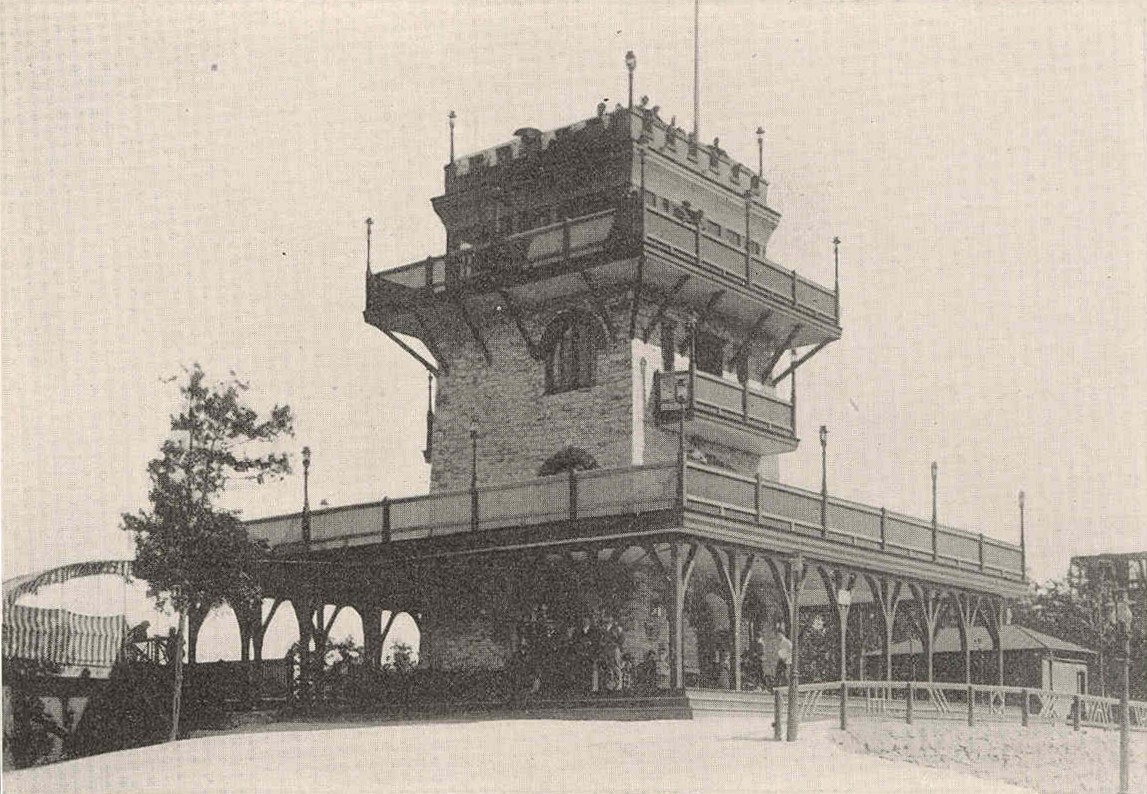
The Tower
The citizens of Reading have ever been charitably inclined. Hospitals, tuberculosis sanitariums, benevolent societies, relief societies, bureau of employment, widows' home, home for friendless children, orphans' asylums and other charitable organizations, the people have ever been active in their maintenance. A Board of Health has been well managed for many years.
Various city departments, such as that of public works, are now in charge of the present city government. Formerly they were separately managed by boards duly chosen for their respective purposes. Under its first management the Board of Park Commissioners, with George F. Baer, as president, and Cyrus T. Fox, secretary, did valuable work in laying out the park at the head of Penn Street.
Thus we have endeavored to show the condition of Reading today as compared with what it was in its earliest history, commencing with the laying out of Reading by the Penns in 1748.
Since assembling information concerning the town's early growth, facts have come into the writer's hands showing that purchasers of lots settled upon them before receiving their deeds, built upon them and had children before, finally, their papers, letters patent, or whatever they were called, were received by them and duly recorded. This was, perhaps, owing to the fact that a small payment accompanied the original purchase, and a deed was not given until the contract was completed.
As to the rapid increase in the German population, after the arrival of the first settlers, this was due to the canvassing, by agents of the Penns in Germany, to induce thrifty agriculturists of that country to locate in America. The arrival of more than 30,000 early in the eighteenth century, many of whom were known as "Redemptioners," amply proved the activity of the movement to induce emigration to this country.
The personal recollections of the writer of Reading when it had but little more than 15,000 population are very vivid. These were set forth in an address which the writer delivered on the occasion of the 75th anniversary of the incorporation of Reading as a city in the Assembly Hall of the Boys' High School, on the 16th of March, 1922. The writer was then announced as four days older than the city, having been born here on March 12, 1847. When on March 16th, that year, Reading became a city, the population was 13,044.
The writer can readily recall scenes and incidents of the days of his youth, some of which would probably prove interesting reading. It is marvelous what changes have occurred, and what a city we now find to have been the outcome of the years of diligent effort, commencing when this region still found Indians roaming around.
The writer well remembers the tales of the visits of friendly Indians told him by his mother, who was born along the Schuylkill, several miles north of Reading, in the house in which her grandfather, a revolutionary captain, was born.
After the warlike scenes of the Revolution and the second war with Great Britain, there was a long period of peace, when the fertile lands of Berks County were cultivated by thrifty farmers, who brought the products of the soil to Reading, the county seat.
The town grew with these advantages. Then came the times of great prosperity, due to Reading's unrivaled location; the construction of canals and railroads; the establishment of industrial enterprises, and the development of the commercial city.
Well can I feel happy to have the privilege of writing of my native place, which has grown into a city of great opportunities. How this growth has been accomplished will be shown in the pageants and parades of our grand anniversary week, when our citizens and their guests can demonstrate their appreciation of a city so beautiful and grand.
It is a source of regret to the writer that we are deprived of the attendance of the President of the United States, who promised me to be present, but who was compelled to cancel all engagements made by him prior to his elevation to the Presidency.
His lamented predecessor, Warren G. Harding, was invited by the writer in June, 1922, to participate in the anniversary. He expressed himself pleased, but suggested that the matter be taken up in the summer of 1923 with his private secretary, Mr. Christian.
This was done late in the spring, shortly before the journey to Alaska was undertaken. The reply of the President's secretary was to the effect that a definite answer to the invitation would be given upon his return from the Pacific Coast.
Mr. Christian stated at the same time that Mr. Harding was deeply sensible of the honor done him in renewing the invitation. Unfortunately, Providence willed otherwise.
As for myself, I would repeat the thought of a former occasion, that a native of a place like Reading can well be pardoned for referring to it in the most glowing terms, while at the same time repeating the words of the poet:
Breathes there a man with soul so dead
Who never to himself has said,
This is my own, my native land.
Source: Official Program of the 175th Anniversary of the Founding of Reading, PA, and the 150th Anniversary of the Reading Volunteer Fire Department Sept. 30th to Oct. 6th 1923, ed. by the Chairman of the Publicity Committee, Reading, PA, 1923, p. 145-161.
Submitted by: Nancy.
Last Modified Tuesday, 26-Jan-2021 10:54:50 PST
[an error occurred while processing this directive]